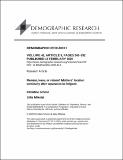Files in this item
Remain, leave, or return? Mothers’ location continuity after separation in Belgium
Item metadata
| dc.contributor.author | Schnor, Christine | |
| dc.contributor.author | Mikolai, Julia | |
| dc.date.accessioned | 2020-02-14T15:30:05Z | |
| dc.date.available | 2020-02-14T15:30:05Z | |
| dc.date.issued | 2020-02-13 | |
| dc.identifier | 262278994 | |
| dc.identifier | 4386cfc0-15b3-407f-9415-3a32288a1f9c | |
| dc.identifier | 000516579900001 | |
| dc.identifier | 85089274179 | |
| dc.identifier.citation | Schnor , C & Mikolai , J 2020 , ' Remain, leave, or return? Mothers’ location continuity after separation in Belgium ' , Demographic Research , vol. 42 , 9 , pp. 245-292 . https://doi.org/10.4054/DemRes.2020.42.9 | en |
| dc.identifier.issn | 1435-9871 | |
| dc.identifier.other | ORCID: /0000-0002-7733-6659/work/69029563 | |
| dc.identifier.uri | https://hdl.handle.net/10023/19469 | |
| dc.description | Christine Schnor acknowledges support from the European Research Council (ERC) under the European Union’s Horizon 2020 research and innovation programme (FAMILYTIES project: Grant Agreement No. 740113 (2017-2022), PI Clara H. Mulder, Rijksuniversiteit Groningen; GENDERBALL project: Grant No. 312290 (2013-2017), PI Jan Van Bavel, KU Leuven). Júlia Mikolai acknowledges support from the Economic and Social Research Council (PartnerLife project; Grant No.: ES/L01663X/1 (2014-2017), PI: Hill Kulu, University of St Andrews) under the Open Research Area (ORA) Plus scheme. | en |
| dc.description.abstract | BACKGROUND Partnership dissolution can mark an extended period of residential instability for mothers and their children. Location continuity, i.e., the ability to stay in or return to the same neighbourhood after separation, is essential to reduce the negative consequences of separation. OBJECTIVE We focus on mothers’ post-separation location continuity in the three years following separation and study the role of socioeconomic resources and local ties (to a home, neighbourhood, and region) in remaining in or returning to their pre-separation neighbourhood. METHODS Using linked Belgian Census (2001) and register data (2001–2006), we estimate multinomial logistic regression models (N = 25,802). Based on the occurrence, frequency, and destination of moves, we distinguish between high, moderate, and low degrees of location continuity. We also study the probability of remaining in, leaving, or returning to the pre-separation neighbourhood. RESULTS Mothers who live at their place of birth (a measure of local ties) tend to stay in or return to their pre-separation neighbourhood or region; if they have more socioeconomic resources they are more likely to remain in the family home. Mothers from disadvantaged backgrounds move further and more often. CONCLUSION If separated mothers lack socioeconomic resources and local ties, they are less likely to maintain location continuity. Policy programmes should target these women in order to provide better opportunities for separated mothers and their children. CONTRIBUTION We introduce the concept of post-separation location continuity and account for separation-induced as well as post-separation residential changes in the first three years after separation. | |
| dc.format.extent | 574135 | |
| dc.language.iso | eng | |
| dc.relation.ispartof | Demographic Research | en |
| dc.subject | Family instability | en |
| dc.subject | Internal migration | en |
| dc.subject | Life course | en |
| dc.subject | Local ties | en |
| dc.subject | Residential mobility | en |
| dc.subject | Separation | en |
| dc.subject | Social inequality | en |
| dc.subject | G Geography (General) | en |
| dc.subject | GF Human ecology. Anthropogeography | en |
| dc.subject | HQ The family. Marriage. Woman | en |
| dc.subject | 3rd-DAS | en |
| dc.subject.lcc | G1 | en |
| dc.subject.lcc | GF | en |
| dc.subject.lcc | HQ | en |
| dc.title | Remain, leave, or return? Mothers’ location continuity after separation in Belgium | en |
| dc.type | Journal article | en |
| dc.contributor.institution | University of St Andrews. School of Geography & Sustainable Development | en |
| dc.identifier.doi | 10.4054/DemRes.2020.42.9 | |
| dc.description.status | Peer reviewed | en |
| dc.date.embargoedUntil | 2020-02-13 |
This item appears in the following Collection(s)
Items in the St Andrews Research Repository are protected by copyright, with all rights reserved, unless otherwise indicated.

